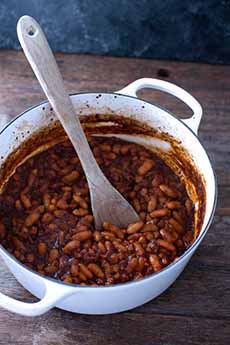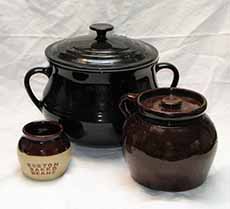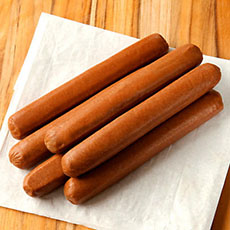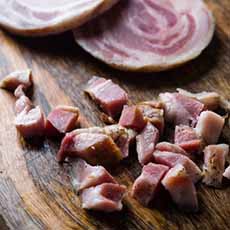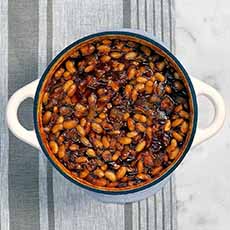Homemade Baked Beans Recipe With Optional Bacon Or Franks
|
|
Sorry, Bush’s, but commercial baked beans are a sorry lot. They should be called “candied beans” for the amount of sugar in them. While baked beans are supposed to have a savory-sweet flavor, the canned varieties we’ve tried really overdo the sweet part. So eschew the canned beans. For Labor Day Weekend or any other festive occasion, bake your own. Unlike one-dimensional canned baked beans, this recipe from DeLallo is layered with flavor from balsamic vinegar, beer and pancetta. July 13th is National Beans ‘N’ Franks Day (or as we grew up saying it, franks and beans). This recipe can be made vegetarian/vegan, or can have added flavor from pancetta/bacon or franks/hot dogs. That’s a lot of “slashes!” Can you use both pancetta and franks? Absolutely! It will deliver a “wow” factor. Check out the different types of bacon. Ingredients 1. PREHEAT the oven to 400°F. 2. COOK the pancetta in a heavy, large, oven-safe pot over medium heat until crisp, about 8 minutes. If using franks, they are pre-cooked so can simply be sliced and added to the bean mixture. 3. ADD the onions and garlic. Sauté until the onions are translucent, about 5 minutes. 4. MIX in the beer, tomato purée, brown sugar, vinegar, molasses, mustard, salt and pepper. Stir in the beans and bring to a simmer. 5. TRANSFER the pot to the oven and bake uncovered, stirring occasionally, until the bean mixture bubbles and thickens slightly, about 45 minutes. Beans have been cultivated worldwide since ancient times, and baked bean dishes grace the cuisines of Europe—from French cassoulet to Portuguese feijoada. However, the types of beans used to make baked beans are native to South America. They were brought to Europe by Spanish explorers around 1528 and traded and planted across North America by Native Americans before then. What Americans call baked beans traces the recipe to different regions, each of which has its own twist on the recipe. While many recipes today are actually stewed, rather than baked, beans, traditionally the beans are slow-baked in a ceramic or cast-iron pot. In New England and elsewhere, a beanpot was used to bake the beans (photo #2). A beanpot (photo #2) is a deep, wide-bellied, short-necked ceramic pots. The relatively narrow mouth of the beanpot minimizes evaporation and heat loss, while its deep, wide, thick-walled body facilitates long, slow cooking times. |
|
|
Boston is called Beantown by outsiders (initially sailors and traders), referring to the popular dish, Boston baked beans—which began as a Native American dish slow-cooked in earthenware pots (photo #2). They taught the technique to the Pilgrims, who in turn embraced the dish which let them avoid cooking on the Sabbath while having a hot meal at the end of it. During the 17th and 18th centuries, Boston was a key port in the rum trade, with ships carrying rum and molasses (a rum by-product) between the Caribbean, Boston, and Africa. Molasses was so plentiful and affordable that cooks put the sweetener in their slow-cooked beans as well as in porridge, dessert, and other dishes. In the U.S., the dish dates back to pre-colonial America, when Native Americans cooked beans in They later taught the technique to the Pilgrims, who borrowed the slow-cook method as a way to avoid working during the Sabbath. With the advent of canned food in the mid-1800s, canned baked beans were among the first convenience foods, called “pork and beans” or “beans with pork.” Then as now, the pork component is typically a piece of salt pork fat [source]. Check out the history of beans and the history of hot dogs. *Pancetta is Italian back bacon, available smoked or unsmoked. By comparison, American “streaky bacon,” also available smoked or unsmoked, is cut from the belly of the pig—one of the fattiest parts of the animal. Check out the different types of bacon.
|
||
